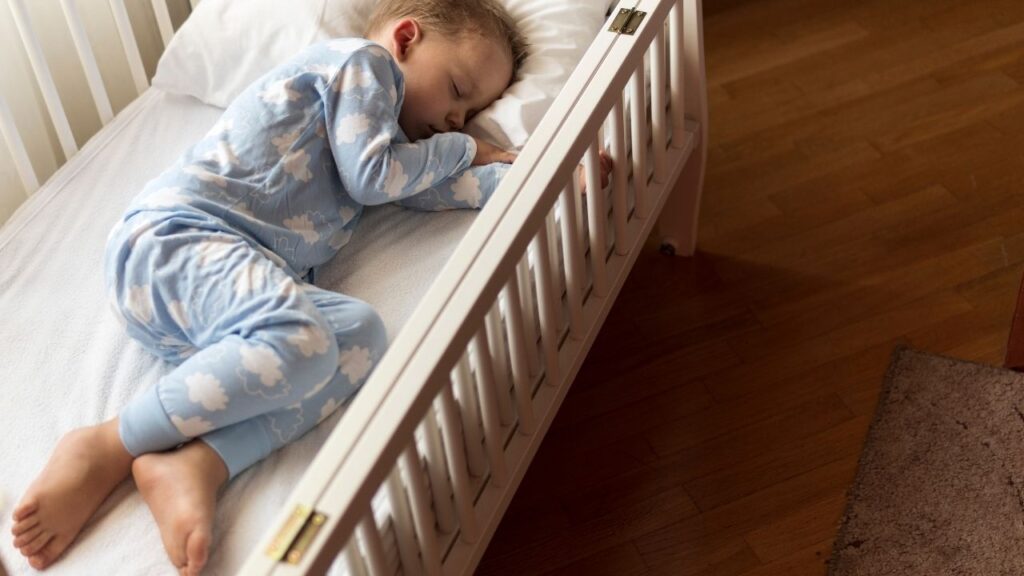You might wonder when to transition to toddler bed for your child. Most children make the switch between 18 months and 3 years old, but experts say readiness matters more than age.
Some recommend waiting until your child is at least 2.5 years old, especially if they have not started climbing out or seem content in their cot. Every child grows at their own pace, so trust your instincts and focus on safety and comfort.
Key Takeaways
- Wait until your child is ready to move. Look for signs like climbing out of the cot. Your child may also show interest in a big bed. They might need easier toilet access too.
- Most children move between 18 months and 3 years. Safety and comfort are more important than age. Trust your instincts and watch your child’s behaviour.
- Pick a strong, low toddler bed with guardrails. Make sure the bedroom is safe for your child during this change.
- Keep the same bedtime routine each night. Use rewards like sticker charts to help your child get used to the new bed.
- Be patient and do not rush the move. If your child finds it hard to settle or feels worried, wait. Every child gets used to a new bed at their own speed.
When to Transition to Toddler Bed
Age Range
You might hear different advice about when to transition to toddler bed, but most children make the move between 18 months and 3.5 years.
A large study of nearly 2,000 families across the UK, Australia, Canada, New Zealand, and the US found that this is the most common age range for the switch.
Many parents wait until their child is about 3 years old. At this age, toddlers usually have better motor skills and more independence, which makes the transition safer and smoother.
Tip: Babies under 18 months are usually too small for a toddler bed. It’s best to wait until your child is at least this age.
Some parents decide to move their child earlier, especially if their toddler starts climbing out of the cot.
About one third of families make the change between 18 months and 2 years, often because of safety concerns. Others wait longer, especially if their child sleeps well in the cot and shows no signs of wanting to leave it.
Here’s a quick look at what experts and organisations say:
| Source / Organisation | Recommendation on Transition Age or Criteria | Notes |
|---|---|---|
| American Academy of Pediatrics (AAP) | Move when your child reaches about 35 inches (89 cm) in height | At this height, children can climb out, which is a safety risk. No strict age guideline. |
| Most Paediatricians | Usually between 18 months and 3 years, closer to 3 if possible | Waiting may help with better sleep and health outcomes. |
| Developmental Readiness Approach | Focus on your child’s ability and maturity, not just age | Transition should not happen before 18 months. |
Readiness
Age is only part of the story. When to transition to toddler bed depends much more on your child’s readiness. Every child is different, so you need to look for signs that your toddler is prepared for this big step.
Some key signs include:
- Your child climbs or tries to jump out of the cot, which can be dangerous.
- The cot feels cramped, or your child’s chest is above the cot railing.
- Your toddler asks about a “big kid” bed or shows excitement about sleeping in one.
- Potty training is underway, and your child needs easier access to the toilet at night.
- Your child can follow simple bedtime routines and understands basic rules about staying in bed.
Note: If your child is comfortable sleeping in new places or can stay in bed without much supervision, these are good signs of readiness.
Experts say you should not rush the process. If you move your child before they are ready, you might face more bedtime battles, night wakings, or even safety issues.
Children under 3 often find it hard to stay in bed, which can lead to more stress for everyone. Waiting for clear signs—like your child asking for a new bed or outgrowing the cot—helps make the transition smoother.
When to transition to toddler bed is a personal decision. Some children show all the signs early, while others need more time. Trust your instincts and watch your child’s behaviour. If you see the signs above, your child is probably ready. If not, it’s okay to wait a bit longer.
Readiness Signs
Every child is unique, so you might notice different signs that your toddler is ready for a big kid bed. Not every child will show all the signs at once.
Some children move early, while others take more time. Here are the main things to look for when you wonder when to transition to toddler bed.
Climbing Out
Climbing out of the cot is one of the biggest signs. If your toddler starts trying to escape, safety becomes a real concern. In fact, a 2020 survey found that 73% of parents moved their child after they climbed out.
You are not alone if you face this challenge. The numbers show that by age three, up to 87% of children have left their cot, often because they started climbing.
| Age Range (months) | Percentage of Toddlers Transitioned from Cot to Bed |
|---|---|
| 18 to 22 | 37% |
| 24 to 29 | 66% |
| 30 to 36 | 87% |
Height
Height matters too. Most experts, including the American Academy of Pediatrics, say you should move your child when they reach about 35 inches tall.
If the cot rail is less than three quarters of your child’s height, it is easier for them to climb out. This makes the cot unsafe. Many parents also notice their child looks cramped or uncomfortable, which is another sign.
- Move your child if they are 34-36 inches tall.
- Check if the cot rail is less than three quarters of your child’s height.
- Watch for signs of discomfort or lack of space.
Interest
Sometimes, your toddler will tell you they want a bed like yours. They might talk about a “big kid” bed or show excitement when they see one.
Curiosity is a good sign. If your child plays with beds or asks questions, they may be ready. Progress in potty training can also mean your child needs easier access at night.
Bedtime Rules
Can your child follow simple bedtime rules? If they understand instructions like “stay in bed” or “wait until morning,” the transition will be smoother.
Children who sleep well through the night and follow routines often adjust better. If your child struggles with rules, you might want to wait a bit longer.
Remember, not all children will show every sign. Readiness varies, so trust your instincts and watch your child’s behaviour.
Not Ready Yet
Settling Issues
Some toddlers just do not settle well when you move them out of the cot too soon. You might notice more bedtime battles, frequent night wakings, or your child getting out of bed again and again.
This is common if your child is under 2.5 years old. At this age, most toddlers do not fully understand the rule to stay in bed. Moving too early can actually make sleep problems worse, not better.
If your child struggles to settle, try these expert backed strategies:
- Stick to a predictable bedtime routine every night.
- Use comfort objects like a favourite teddy or a parent’s shirt for extra security.
- Set clear limits on bedtime activities and stick to them.
- Respond the same way each time your child gets up, so they know what to expect.
Consistency helps your child feel safe and learn what bedtime means.
Anxiety
Anxiety can show up in many ways when your child is not ready for a toddler bed. You might see more clinginess, tantrums, or even physical complaints like tummy aches.
Some children avoid bedtime or ask for extra reassurance. These behaviours often mean your child feels worried about the change.
You can help by:
- Talking about their feelings and letting them know it’s okay to feel nervous.
- Using calming techniques like deep breathing or a gentle bedtime story.
- Keeping routines steady and using visual schedules for predictability.
- Giving them a comfort object or a wearable charm to remind them of you.
Children feel safer when they know what will happen next. If anxiety is strong, waiting a bit longer before moving to a bed can make the transition much smoother.
Still Fits Cot
If your child still fits comfortably in the cot and shows no signs of climbing out, there is no rush. Many experts agree that waiting until your child is at least 2.5 years old is best, unless safety is a concern.
You know your child best. Trust your instincts and do not feel pressured to move them before they are ready.
- If you are expecting a new baby, consider using a bassinet or playpen for the newborn instead of rushing your toddler out of the cot.
- Involve your child in the process when the time comes, but remember, there is no set deadline.
Patience, consistency, and listening to your child’s needs will help you find the right time for this big step.
Safety Tips
Bed Choice
Choosing the right toddler bed makes a big difference to your child’s safety. You want a bed that feels sturdy and secure. Look for these features when you shop:
- A solid frame made from wood or metal with no loose parts.
- Rounded corners and smooth edges to prevent bumps and scrapes.
- A low height so your child can climb in and out easily.
- Non toxic materials, free from harmful chemicals like lead.
- A mattress that fits snugly, leaving no gaps at the sides.
- Firm support, as soft mattresses can be unsafe for toddlers.
- Safety certifications that show the bed meets current standards.
Tip: Keep the bed free from loose bedding, pillows, and toys. This follows safe sleep guidelines and helps reduce risks.
Guardrails
Guardrails help keep your child from rolling out of bed at night. They act as a barrier and give you peace of mind. Not all beds come with guardrails, so check before you buy.
Here’s what makes a good guardrail:
| Feature | What It Means | Why It Matters |
|---|---|---|
| Minimum Height | At least 5 inches above the mattress | Stops your child from falling out |
| Strong Construction | Withstands up to 50 lbs of force | Stays in place even if your child leans on it |
| Sturdy Slats/Spindles | Tested to hold 80 lbs without breaking | Prevents injuries from broken parts |
| Secure Fittings | No loose or wobbly parts | Reduces risk of entrapment or falls |
Most injuries from toddler beds happen because of falls. Guardrails designed to these standards help prevent accidents and keep your child safer at night.
Childproofing
Once your child moves to a bed, they can get up and explore. You need to make the bedroom as safe as possible. Here are some simple steps:
- Place the bed away from windows, curtains, and cords.
- Anchor furniture to the wall to stop it tipping over.
- Cover electrical outlets and keep cords out of reach.
- Use childproof locks on drawers and doors.
- Remove small objects and choking hazards from the room.
- Keep the room tidy and clutter free.
- Use a safety gate at the bedroom door if needed.
- Add a night light to help your child see if they get up at night.
Note: Check the room regularly for new hazards. Fix anything unsafe straight away. Your child’s safety always comes first.
Smooth Transition
Involve Your Child
You can make the move to a toddler bed much easier by involving your child in the process. Let them help pick out new bedding, a favourite night light, or even a special comfort toy.
This gives your child a sense of ownership and makes the change feel exciting rather than scary. Some parents find that letting their child choose stickers or a small pillow helps them feel more grown up and independent.
Tip: Start by using the new bed for nap times. This gentle approach helps your child get used to the new sleeping space without too much pressure.
If you have other big changes coming up, like a new sibling or starting nursery, try not to introduce the toddler bed at the same time. Too many changes at once can feel overwhelming for little ones.
Routine
A steady bedtime routine is your best friend during this transition. Children thrive on predictability. When you follow the same steps each night—like a warm bath, brushing teeth, putting on pyjamas, reading a story, and saying goodnight—your child knows what to expect. This helps them wind down and feel safe.
- Use a visual tool, such as a simple chart or the ‘Stoplight System’, to show when it’s time to stay in bed.
- Remind your child of sleep rules during the routine. For example, “Red light means stay in bed until morning.”
- If your child wakes up at night, calmly return them to bed and reassure them.
Keeping the routine consistent builds your child’s confidence and helps them settle more quickly in their new bed.
Positive Reinforcement
Encourage your child to stay in their bed by using positive reinforcement. Sticker charts work wonders for many families.
Let your child choose their own stickers and place one on the chart each morning they stay in bed all night. Celebrate small wins with praise or a special treat, like choosing the bedtime story.
- Phrase sleep rules in a positive way, such as “Lie quietly in bed” instead of “Don’t get up.”
- Set clear goals, like “Stay in your bed until 6:00 a.m.”
- Offer small rewards or privileges as the chart fills up.
Remember, patience and consistency are key. Celebrate progress, no matter how small, and keep bedtime a positive experience.
You might feel pressure to move your child to a toddler bed by a certain age, but waiting for signs of readiness makes the process smoother.
Many parents find success when they:
- Watch for cues like climbing or showing interest in a new bed.
- Stick to familiar routines and involve their child in the change.
- Use safety measures such as guardrails and childproofing.
Setbacks happen. Some children adjust quickly, while others need more time. Stay patient, keep boundaries clear, and remember—every child’s journey is different.
FAQ
What if my child keeps getting out of bed?
You might find your child gets up often at first. Stay calm and gently return them to bed each time. Keep your response the same. This helps your child learn bedtime rules. Consistency works best.
Can I skip the toddler bed and go straight to a single bed?
Yes, you can move straight to a single bed if you feel your child is ready. Just make sure the bed is low and has guardrails. Add extra pillows on the floor for safety.
How long does it take for a child to adjust to a toddler bed?
Most children need a few days to a few weeks to settle in. Some adjust quickly, while others take longer. Stick to your routine and offer lots of praise. Patience helps your child feel secure.
Should I move my child if a new baby is coming?
If your child is not ready, wait if you can. Try not to rush the move just because a new baby needs the cot. Use a bassinet for the baby or wait until your toddler shows readiness signs.



